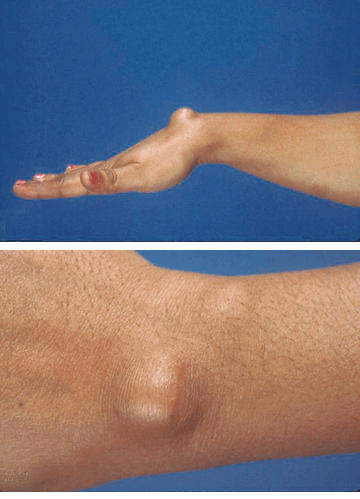Ganglion CYST
the most common tumor of the hand
Clint Merrick, MD
Hand, Plastic and Reconstructive Surgery
Rucker & Merrick Plastic Surgery Clinic
Eau Claire
Some of the most common problems seen by a hand and upper extremity surgeon are ganglion cysts. In fact, ganglions are the most common masses found in the hand, accounting for up to 70% of all tumors. These benign cysts can appear anywhere in the wrist, hand or fingers, but have specific sites where they are most common. Most people report that the cysts grow slowly – from months to years. Patients describe an aching pain, changes in the size of the mass, self-consciousness related to the lump, and a variety of other symptoms. These cysts are often very firm and feel ‘fixed’ to the deeper tissues in the hand or wrist.
Ganglions arise from the joints in our bodies. Often these result from minor trauma or degeneration of the joint capsule, especially due to arthritis. The joint capsule is a thick layer of ligaments that cover our joints and keep our bones in alignment. The trauma or degeneration results in small tears or holes in the capsule which permits the escape of joint fluid. Our bodies react to encapsulate the fluid and the result is a ganglion cyst. Over time, these cysts become lined with joint fluid producing cells. Often these cysts will increase or decrease in size. Sometimes they will rupture, but they usually recur. Historically, one treatment of these cysts was to hit them with a heavy book.
Rarely, due to their location, ganglions may be associated with other conditions of the hand. Ganglions within the carpal tunnel, for example, may exert pressure on the median nerve and give symptoms similar to carpal tunnel syndrome. Ganglions that develop next to our tendons may result in trigger finger. Finally, ganglions in the last joint in the fingers may result in joint infections and nail abnormalities. These cysts, called mucous cysts, are covered in more detail in our Profiles publication, please call our office or visit our website (www.rucker-merrick.com) for a copy of this article.

While ganglions may be left alone with little risk for general health problems, these masses typically get bigger and rarely go away on their own. In some cases, draining the fluid from the cyst can be successful in reducing its size and alleviating the symptoms.
Because this treatment is aimed only at the symptoms, it does not treat the root of the problem and therefore recurrence is very common. Similarly, rupture of the cysts is only a temporary treatment with recurrence rates as high as 90%.
The most effective treatment for a ganglion, with the lowest incidence of recurrence, is to surgically remove it. This minor surgical procedure, performed under a regional (arm numbing) anesthetic, is a short, very well tolerated operation. The cyst is carefully dissected, the ‘stalk’ by which the cyst is connected to the joint is identified, and the small hole in the joint capsule is meticulously repaired. Complications are rare and can include bleeding and infection.
Ganglions are very common problems. The good news is that they are not malignant and will not spread or cause systemic problems. Although they may increase and decrease in size, they rarely go away on their own. Fortunately, with surgical removal, the risk of recurrence is limited to 15%.
For more information on ganglion cysts or to schedule an appointment with Dr. Clint Merrick, Rucker & Merrick Plastic Surgery Clinic, call 800.456.8222 or visit Rucker-Merrick.com. Dr. Merrick sees patients in Eau Claire, Chippewa Falls, Cumberland and Rice Lake.




